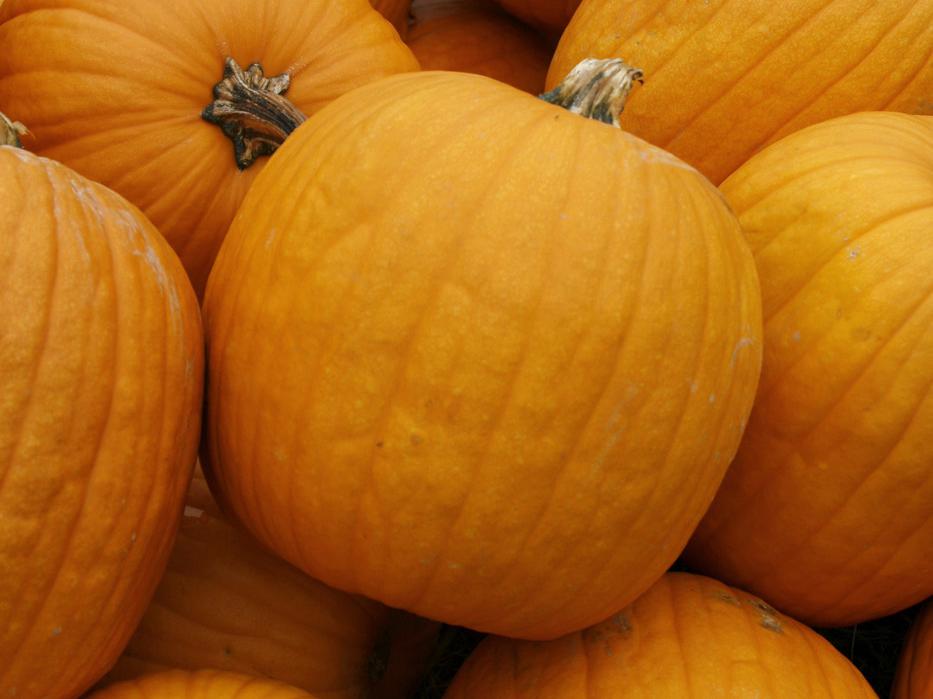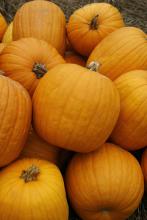Information Possibly Outdated
The information presented on this page was originally released on October 16, 2009. It may not be outdated, but please search our site for more current information. If you plan to quote or reference this information in a publication, please check with the Extension specialist or author before proceeding.
Rain affects pumpkin quantity, not quality
By Karen Templeton
MSU Ag Communications
MISSISSIPPI STATE – Heavy rains in Mississippi and nationwide have decreased the number of pumpkins available for harvest, but not the quality of the pumpkins already pulled from the fields.
Pumpkins are popular in the fall for decorating and baking, but they are not a major crop for Mississippi, which only has a few commercial growers.
“Unfortunately, growers lost 20 percent or more of their pumpkins in this part of the state,” said Steve Cummings, Mississippi State University Extension Service director for Yalobusha County. “The rains delayed fungicide application, so some of the pumpkins were lost to rot.”
Cummings said the pumpkins harvested were of good to excellent quality and are selling quickly. Despite the heavy rains, this has been the case for sod farmer and pumpkin grower Kyle Jeffreys in Coffeeville.
“The conditions for planting pumpkins were good this year. After that first month or so, we got some rain that drowned some of the vines,” Jeffreys said. “However, that didn’t affect them too much. It was the 17 straight days of rain that really took a toll.”
Without timely fungicide applications, farmers lost some of the harvest to stem rot.
“I lost about 20 percent to 30 percent of the pumpkin crop this year,” Jeffreys said. “But the quality of the harvested pumpkins has been excellent. I’ve already sold all of them.”
Jeffreys grew 10 acres of pumpkins and sold about 10,000 to retailers and wholesalers in the state.
“They bought them up fairly quickly to ship out to their customers,” Jeffreys said. “Without the heavy rain, I could have gotten the fungicides applied and saved about 3,000 pumpkins. Overall, though, I’m happy with what we salvaged and sold.”
Clay County Extension agent and pumpkin grower Reid Nevins avoided rainfall issues by harvesting his 4 acres early.
“This is the best crop I’ve ever had,” Nevins said. “We got them out of the fields and ready to go by Oct. 1.”
Like Jeffreys, Nevins has sold all of his pumpkins. Many of his pumpkins weighed between 50 and 100 pounds and were in high demand.
“Mississippi does not have the most ideal pumpkin growing conditions, mostly because of the humidity,” Nevins said. “So what we do grow here, we are able to sell fairly quickly.”
Nevins’ pumpkins were sold to wholesalers, the West Point co-op and farmers’ markets.
“Mississippi’s pumpkin crop has been spotty depending on what area of the state the pumpkins are in. Overall, there was a lot of loss,” said Ken Hood, Extension professor in the Department of Agricultural Economics.
“This is the case all over the country, especially in the Northeast where they are experiencing a pumpkin shortage,” he said.
Hood said the Midwest’s pumpkin crop has fared well, and most of the pumpkins consumers buy this year will be from that region. Many of those who sell pumpkins in Mississippi already purchased pumpkins from the Midwest to supply their markets.
“Prices are higher than last season, mainly because of the shortages in most of the country,” Hood said. “The prices are ranging from 29 cents per pound up to 59 cents per pound wholesale. Last year, the average was about 30 cents per pound wholesale.”
Hood said shortages will be seen in carving and decorative pumpkins, and also in canned pumpkin meat and products. To compensate, some retailers are replacing pumpkins with small gourds to sell for decorative purposes.
“Of course the shortage is not good news, but Mississippi is not a big pumpkin-producing state,” Hood said. “What was harvested here is selling for good prices.”







